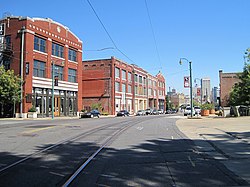South Main Street Historic District (Memphis, Tennessee)
South Street Historic District | |
 South Main, looking north from Longshot, in 2010 | |
| Location | Roughly S. Main St. between Webster and Dr. Martin Luther King Junior Avenues, and Mulberry between Calhoun and Vance Avenues, Memphis, Tennessee |
|---|---|
| Area | 20 acres (8.1 ha) |
| Architect | Multiple |
| NRHP reference No. | 82004054[1] (original) 97000224[2] (increase 1) 99000756[3] (increase 2) 13000503[4] (increase 3) |
| Significant dates | |
| Added to NRHP | September 2, 1982 |
| Boundary increases | March 8, 1997 July 9, 1998 August 13, 2013 |
The South Main Street Historic District in
Rail expansion
The first station in the district was on Calhoun Street, built c. 1855 by the
Original district
When added to the register in 1982, the district contained 105 structures and a few vacant lots. Of these, only six were considered to be "non-contributing" with either little or no "historic or architectural significance", or significantly altered from their original appearance or otherwise out of character with the district.[8]
The district includes South Main Street between Linden and Webster; and Mulberry Street, which parallels Main, between Vance and Butler. There are also buildings fronting Butler, Calhoun, Huling, Pontotoc, and Vance near their intersections with Main and Mulberry. Most buildings are one to three stories, with a few taller. Almost all buildings in the district are
The most prominent building in the district is Memphis Central Station, which opened in 1916 and is not the only remaining passenger station in the city. Many of the other buildings in the district were built to serve railroad travelers. They included hotels, restaurants, bars, and similar places. Also located in the district were businesses that made heavy items and which were shipped by rail and located there to reduce transportation costs. The area had previously been a "fashionable residential area of Memphis", but most residences were replaced with commercial buildings. A few large houses survived as hotels.[8]
Increases
An increase in 1997 added the 1914 Railway Express Agency Building at 663 S. Main St as significant to the history of rail-related transportation in Memphis and a good example of a freight-handling business.[2]
An increase in 1999 added 384 Mulberry and 129 Talbot, two identical buildings built as examples of African-American tenement housing in Memphis, both built c. 1905.[3]
A third increase occurred in 2013 when 124–125, 136–137, 148, 153, 154, 158, and 161 G.E. Patterson Ave., and 138 St. Paul Ave. were added to the district as additional good examples of freight-handling businesses significant to the rail history of Memphis.[4]
Redevelopment
The area, which declined with the rail industry after World War II, gained national notoriety after King's assassination at the
The National Civil Rights Museum, originally the Lorraine Motel, opened in 1991.[10] The Orpheum Theatre, located on South Main just a block outside the district, is also individually listed on the National Register of Historic Places.[11]
References
- ^ a b "National Register Information System – (#82004054)". National Register of Historic Places. National Park Service. November 2, 2013.
- ^ a b "National Register Information System – (#97000224)". National Register of Historic Places. National Park Service. November 2, 2013.
- ^ a b "National Register Information System – (#99000756)". National Register of Historic Places. National Park Service. November 2, 2013.
- ^ a b "National Register of Historic Places Program, South Main Street Historic District (Boundary Increase)". nps.gov. National Park Service. Retrieved December 27, 2020.
- ^ "Go South Main".
- ^ a b "Home What We Do Get Involved Membership/Join Now Historic Memphis The Keystone Contact Us MHI Store Newman's Memphis Photos South Main Street Historic District". memphisheritage.org. April 4, 2018. Retrieved December 30, 2020.
- ^ "Memphis, TN – Central Station (MEM)". The Great American Stations. Retrieved December 30, 2020.
- ^ a b c "National Register of Historic Places Inventory/Nomination: South Main Street Historic District". National Park Service. Retrieved December 27, 2020. With accompanying pictures
- ^ "Before & After: Memphis' South Main Historic District". thejaxsonmag.com. December 6, 2018. Retrieved December 30, 2020.
- ^ Cornish, Audie (December 16, 2007). "Mission of National Civil Rights Museum Questioned". NPR. Retrieved February 13, 2015.
- ^ "National Register Information System – (#77001289)". National Register of Historic Places. National Park Service. November 2, 2013.


